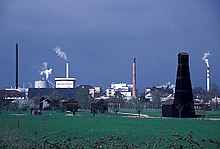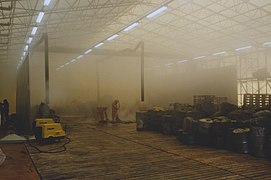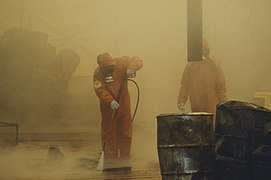Major fire in Schweizerhalle
The major fire in Schweizerhalle occurred on 1 November 1986 in the industrial area " Schweizerhalle " in Basel in Switzerland, as a warehouse of the former chemical company Sandoz (now Novartis ) with chemicals in fire fell. In the episode came with pesticides contaminated fire water into the Rhine, which downriver to a fish kill to Mannheim led. An additional pollution of the Rhine water with a red dye, which was non-toxic, was visible from afar. The smelly cloud of smoke blowing in the direction of Basel and the siren alarm triggered in the region awakened ominous memories of the chemical disaster in Bhopal on December 3, 1984.
Course of the accident

The fire started in a hall in which 1,351 tons of chemicals were stored. The fire was discovered at 12:19 am; the 160 firefighters limited themselves to protecting surrounding buildings from the flames spreading; they were up to 60 m high and could be seen from afar at night.
At 3:43 a.m., the authorities arranged for the population of the neighboring communities (including Muttenz and Basel) to be warned with a general siren alarm and with loudspeaker announcements to keep doors and windows closed and to listen to the news on the radio. The prevailing easterly wind carried smoke, stench and the combustion gases of unknown composition towards Basel. The closure of the nearby Autobahn 2 and 3 and the interruption of the train connections to Basel led to a standstill until the authorities gave the all-clear around 7:00 a.m. A phosgene tank next to the hall was spared from the fire.
Several people suffered acute damage from the fire - three people with asthma who were being treated in a hospital; In the following days, over 1250 people had to be treated for irritation of the respiratory tract .
With the outflowing fire fighting water (approx. 10'000 to 15'000 m³) around 30 tons of pesticides ended up, v. a. the insecticides Disulfoton , Thiometon , Parathion and Fenitrothion in the Rhine ( half-life of 30 to 50 days).
There they caused great fish deaths as far as the Middle Rhine , in particular the entire eel population (approx. 150,000 individuals) was wiped out over a length of 400 km . A peak concentration of 25 μg / l Disulfoton was measured in Karlsruhe . The waterworks downstream were only informed on November 3rd.
On November 11, 1986, the analysis of water samples proved that at the same time as the pollution of the Rhine from the contaminated fire-fighting water from the Sandoz area, 0.4 tonnes of atrazine had been discharged into the Rhine from the neighboring chemical company Ciba-Geigy .
The dynamic river system and the organisms had recovered from the accident after a few months. However, the immigration of exotic species was strongly encouraged, which has an unfavorable effect on the ecological balance. The red dye that got into the Rhine, which was described as harmless, also caused a strong coloration of the water.
causes

The official investigation report came to the conclusion (only “on the basis of theoretical considerations”) that when pallets were packed with Prussian blue, the incorrect handling of a “shrink gun” led to an embers. Max Hubmann, at that time head of the scientific service of the Zurich City Police, investigated the cause of the fire on site; His conclusion: "It is very likely that the shrinkage of plastic over Berlin blue was the cause of the major fire."
Sandoz already knew in the mid-sixties that the agro-marking dye Berlin blue tends to glow fires with a later outbreak of fire, as can be seen from internal documents which the Basler Zeitung published in excerpts in 2000; she noted:
"For example, a Sandoz employee wrote in an internal paper on November 18, 1965:" When Berlin blue is heated, it fades. "In addition, when the fabric was ground at the Basel plant, an" ignition "occurred. Four years later this was confirmed by a further internal Sandoz paper: On July 25, 1969, the French subsidiary reported to the Basel headquarters that Berlin blue was more fire hazardous than previously assumed: ‹The product burns very slowly, without flames.› That in Berlin blue The company Degussa as the supplier of the dye confirmed on their safety data sheet two years before the major fire in the Sandoz warehouse : ‹Avoid contact with ignition sources (fire, sparks). Dust deposits are to be avoided. ›Nonetheless, on October 31, 1986, the Sandoz worker worked with an open flame to fix the containers with Berlin blue on transport pallets using shrink film . Shortly afterwards, on the night of November 1st, the warehouse in Schweizerhalle was on fire. Nine days after the conflagration, on November 10, 1986, A. Aellig from the Sandoz security laboratory confirmed in a letter to Max Hubmann what the Sandoz Group had known for a long time: After the major fire, fire tests had shown that Berlin blue was there ‹A very easy flammability› shows ‹and then a flameless, smokeless, slowly progressing glow› develops.
Based on this report and with its own findings as a basis, the Zurich City Police's scientific service started its own fire tests, Hubmann recalls, according to the Basler Zeitung. In the presence of the accused worker, the public prosecutor's office in Basel-Landschaft and representatives of the Sandoz, they would have “done pretty well” the glow of the Berlin blue. They did not work with an open flame during these fire tests, as the Sandoz worker had done before the major fire, but used hot nails. There was always a little dye between the sacks and the shrunken plastic. ‹We poked our hot nails through the plastic film. This enabled us to make the Berlin blue glow outside the sack. ›After that, it took a long time for your sample range of Berlin blue to burn openly. This explained why so much time had passed between the storage of the Berlin blue pallets in the warehouse and the open fire. However, they could not have clarified exactly where in the hall the pallets were in front of the fire.
The fact that the Sandoz worker was not convicted despite the knowledge about the fire hazard of Berlin blue and his handling of an open flame does not call into question for Hubmann the probability that the cause of the fire was in the Berlin blue: ‹That is a legal assessment has nothing to do with the cause of the fire. ›And:‹ It is very likely that the shrinkage of plastic over Berlin blue was the cause of the major fire ›.
In March 2017, the Basler Zeitung published new research that questioned the official cause of the fire, “Berlin Blue”. Former Sandoz employees told the newspaper that a large fireworks display had been planned for a departing management employee on the day of the fire. The fireworks had been deposited in warehouse 956. According to the investigators, the fire broke out in this hall. The Sandoz employees name the accidental ignition of the fireworks as the actual cause of the fire. So far this has not been officially confirmed.
consequences
Fighting the Schweizerhalle fire disaster led to the immediate soil and groundwater contamination of the site due to the seepage of large amounts of contaminated fire fighting water. The subsequent renovation took place in close consultation with the responsible supervisory authorities, the Office for Environmental Protection and Energy Basel-Landschaft (AUE BL), but only achieved two of three specified renovation targets. The re-assessment of contaminated sites by AUE BL on September 21, 2011, which is provided for in the Ordinance on Contaminated Sites introduced in 1998, came to the conclusion that no further remediation measures were necessary, as the measured oxadixyl concentrations only reached 0.2% of the legally defined remediation value. In the course of the reassessment, the AUE BL also came to the conclusion that the drinking water catchments of Hardwasser AG and the Muttenz community were not endangered by the Schweizerhalle accident site. According to Swiss law on contaminated sites , the Schweizerhalle accident site is a contaminated site that needs to be monitored: documents prepared by Sandoz for an insurance company show that the remains of fire are 8,700 kilograms of partly highly toxic pesticides and 134 kilograms of mercury ; According to the Swiss Federal Office for the Environment, the polluted soil was dug and washed to a depth of 11 m and the area was covered with a concrete slab.
In 2016, traces of the pesticide oxadixyl were still detectable on the ground . At the beginning of 2017, a legal re-assessment of the hazard posed by the fire site was carried out.
As a consequence of the accident, Sandoz recognized the need to improve the information base for risks and developed one of the first sustainability management systems , now known as doCOUNT 2.0 Sustainability Performance Management Suite . To commemorate the catastrophe, there is a plastic market table by Bettina Eichin in the cloister of Basel Minster .
The relevant ministries of the Rhine States in cooperation with the International Commission for the Protection of the Rhine enacted the Rhine Action Program , a device to warn residents Rhine ( Rhein alarm ).
Documentation

- Chemical fire disaster in Schweizerhalle in: Swiss television on November 27, 1986 (9:31 minutes)
- 20 years after Schweizerhalle in: MTW of October 26, 2006 (12:28 minutes)
- When Switzerland held its breath: The Schweizerhalle fire in: DOK of July 19, 2011 (37 minutes); Online video
- False alarm , radio feature by Lukas Holliger , Radio SRF 2016.
- Dossier Schweizerhalle of the Federal Office for the Environment (2016)
reception
- Lukas Holliger , 2016: False alarm . Radio play based on live reports from Radio Basilisk and special broadcasts by DRS media ( Schweizer Radio DRS , Schweizer Fernsehen ) on the Sandoz accident.
See also
literature
- Schweizerhalle , Report of the Government Council to the District Administrator (Baselland), 1987
- Nikolai A. Behr: The development of the Rhine protection regime with special consideration of the Sandoz accident of November 1, 1986 ; brain script-Verlag, Munich 2003, 228 pp., ISBN 3-9808678-0-3 .
- Walter Giger : The Rhine is red, the fish are dead: Fire disaster in Schweizerhalle in 1986 - review and balance sheet , in: UWSF , 19 (1), 11–23, doi: 10.1065 / uwsf2007.03.165
- Martin Forter: Wrong game. The environmental sins of Basel chemistry before and after «Schweizerhalle». Chronos Verl., Zurich 2010, ISBN 978-3-0340-1007-8
- Martin Forter: Play of colors. A century of environmental use by the Basel chemical industry. Chronos Verl., Zurich 2000, ISBN 978-3-905313-46-8
- Max Thürkauf : The Chernobal Fanal . Christiana-Verlag, Stein am Rhein 1987, ISBN 3-7171-0895-6 ("Tschernobal": pun on Chernobyl and Bâle because of the major chemical fire in Schweizerhalle in the same year as the Chernobyl nuclear disaster )
- Christian Koller : 30 years ago: Chernobyl and Chernobâle , in: Sozialarchiv Info 6 (2016). Pp. 4-12.
Web links
- martinforter.ch : Article on “Schweizerhalle” and “Schweizerhalle” landfill (“Geographer and contaminated site expert”)
- webjournal.ch: Theater Basel is looking for contemporary witnesses , October 3, 2010 (contemporary witnesses report 20 years later)
- Nils Freytag: The Red Rhine. The Sandoz disaster of November 1, 1986 and its aftermath. In: European History Thematic Portal. 2010, accessed July 1, 2020 .
Individual evidence
- ↑ a b c d badische-zeitung.de , background , October 31, 2016, Franz Schmider: Poison cloud over the border triangle (November 3, 2016)
- ↑ a b c d heimatkunde-muttenz.ch: The major fire in the Schweizerhalle in 1986 , accessed on October 31, 2016
- ^ A b c d e Franz Schmider: Since the Sandoz disaster, the Rhine has become cleaner . In: badische-zeitung.de , October 31, 2016, accessed on October 31, 2016.
- ↑ a b Questions and answers on the Schweizerhalle fire from 1986 - facts about the Schweizerhalle (PDF; 41 kB). Catalog of questions and answers from the Office for Environmental Protection and Energy Basel-Landschaft on the subject of the Schweizerhalle. Retrieved July 26, 2012
- ↑ Walter Giger: The Rhine red, the fish dead. Fire catastrophe in Schweizerhalle 1986 - review and balance sheet , UWSF - Z Umweltchem Ökotox 19, special edition 1 (2007), doi: 10.1065 / uwsf2007.03.165
- ↑ Walter Reinhard: 25 years of the SANDOZ catastrophe on the Rhine - Effects on water protection , November 23, 2011, accessed on October 31, 2016.
- ↑ We should wake up and think . In: Der Spiegel . No. 47 , 1986 ( online ).
- ↑ The Rhine red, the fish dead - 20 years after the Sandoz fire ( memento of December 8, 2015 in the Internet Archive ). - Eawag media release dated November 1, 2006.
- ↑ The Rhine is alive - but differently ( page no longer available , search in web archives ). Video in: MTW from October 26, 2006 (5:19 minutes).
- ↑ Patrick Müller: Sandoz disaster: "Back then you smelled the Rhine before you saw it" . In: badische-zeitung.de, October 31, 2016, accessed on October 31, 2016.
- ↑ a b Martin Forter: Swiss Hall: Prussian blue as a cause of fire. In: Basler Zeitung of November 22, 2000.
- ↑ Martin Forter: The security did not correspond to the state of the art , in: Berner Zeitung of December 19, 1990.
- ↑ Christian Keller: New trace of the Schweizerhalle fire . In: Basler Zeitung . March 4, 2017 ( bazonline.ch [accessed March 8, 2017]).
- ↑ AUE BL
- ↑ Accident site “Sandoz Fire” in Schweizerhalle: Contaminated site with need for monitoring - press release . Media release from the Office for Environmental Protection and Energy Basel-Landschaft. Retrieved February 2, 2017
- ↑ Contaminated Sites Ordinance
- ↑ a b badische-zeitung.de , November 2, 2016: The soil is still polluted (November 3, 2016)
- ↑ doCOUNT AG website ( Memento from March 18, 2018 in the Internet Archive )
- ↑ PDF of the International Commission for the Protection of the Rhine ( Memento of October 31, 2016 in the Internet Archive ). Accessed November 1, 2016
- ↑ commons: Category: Markttische (Cloister of Basel Münster) : “The artwork Markttische has been in the cloister of Basel Minster since December 2010. It is a work by Bettina Eichin, created around 1986. It consists of two groups of sculptures: One depicts a market table loaded with vegetables, the second an empty market table on its tabletop, the poem Die Vergänlichkeit by Johann Peter Hebel from 1803 is engraved. The indication “ZB, 1. NOV. 1986, 00.19H ", refers to the major fire in the Schweizerhalle, which led to the fact that the work of art was not placed on the [Basel] market square as intended."
Coordinates: 47 ° 32 '7.8 " N , 7 ° 39' 38.9" E ; CH1903: 616,730 / 264,998






